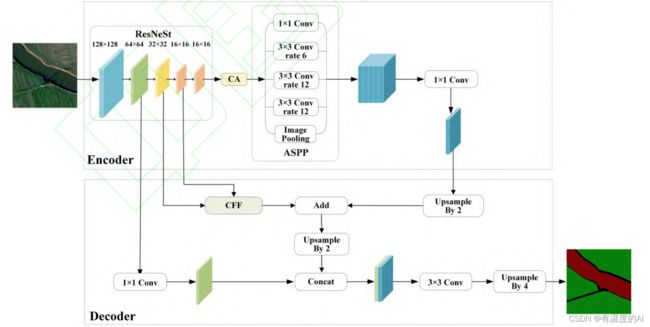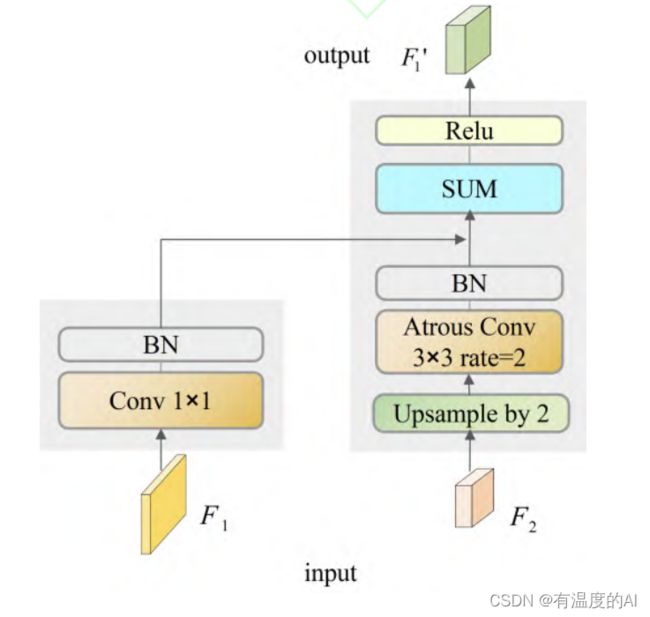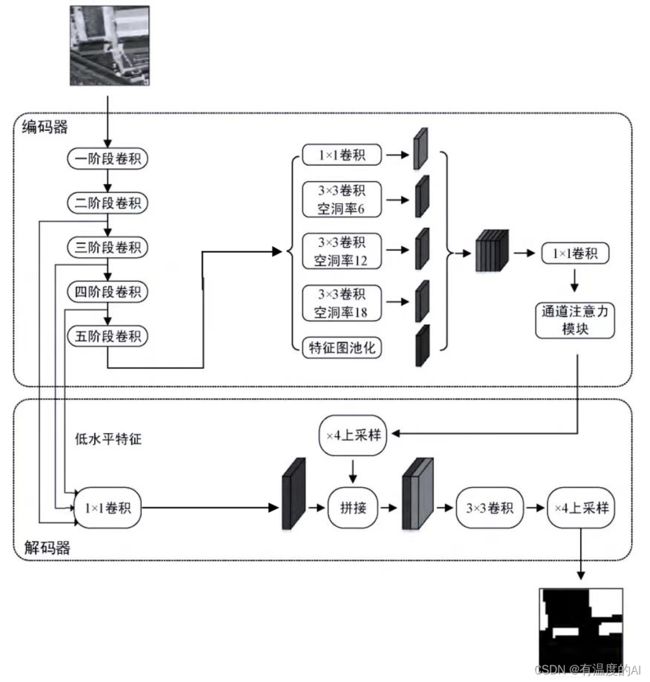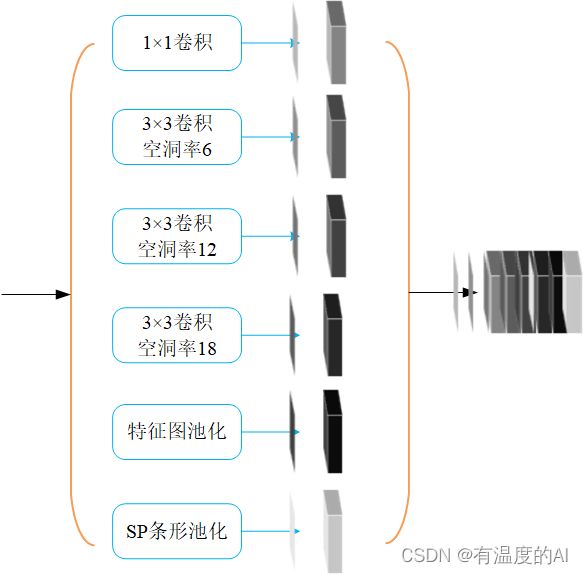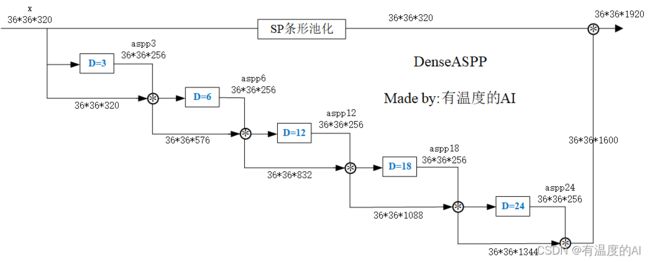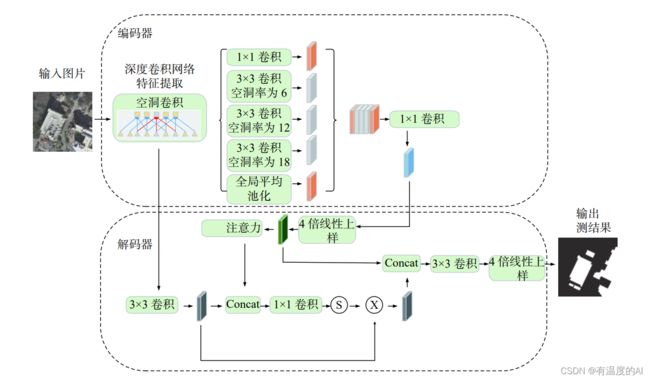改进 DeepLabV3+
网络整体结构图
CFF结构图
import torch
import torch.nn as nn
import torch.nn.functional as F
from nets.xception import xception
from nets.mobilenetv2 import mobilenetv2
class MobileNetV2(nn.Module):
def __init__(self, downsample_factor=8, pretrained=True):
super(MobileNetV2, self).__init__()
from functools import partial
model = mobilenetv2(pretrained)
self.features = model.features[:-1]
self.total_idx = len(self.features)
self.down_idx = [2, 4, 7, 14]
if downsample_factor == 8:
for i in range(self.down_idx[-2], self.down_idx[-1]):
self.features[i].apply(
partial(self._nostride_dilate, dilate=2)
)
for i in range(self.down_idx[-1], self.total_idx):
self.features[i].apply(
partial(self._nostride_dilate, dilate=4)
)
elif downsample_factor == 16:
for i in range(self.down_idx[-1], self.total_idx):
self.features[i].apply(
partial(self._nostride_dilate, dilate=2)
)
def _nostride_dilate(self, m, dilate):
classname = m.__class__.__name__
if classname.find('Conv') != -1:
if m.stride == (2, 2):
m.stride = (1, 1)
if m.kernel_size == (3, 3):
m.dilation = (dilate//2, dilate//2)
m.padding = (dilate//2, dilate//2)
else:
if m.kernel_size == (3, 3):
m.dilation = (dilate, dilate)
m.padding = (dilate, dilate)
def forward(self, x):
#输入shape为576*576*3
low_level_features = self.features[:4](x) #144*144*24
the_three_features = self.features[:7](x) #72*72*32
the_four_features = self.features[:11](x) #36*36*64
x = self.features[4:](low_level_features) #36*36*320
return low_level_features, the_three_features, the_four_features, x
#-----------------------------------------#
# ASPP特征提取模块
# 利用不同膨胀率的膨胀卷积进行特征提取
#-----------------------------------------#
class ASPP(nn.Module):
def __init__(self, dim_in, dim_out, rate=1, bn_mom=0.1):
super(ASPP, self).__init__()
self.branch1 = nn.Sequential(
nn.Conv2d(dim_in, dim_out, 1, 1, padding=0, dilation=rate,bias=True),
nn.BatchNorm2d(dim_out, momentum=bn_mom),
nn.ReLU(inplace=True),
)
self.branch2 = nn.Sequential(
nn.Conv2d(dim_in, dim_out, 3, 1, padding=6*rate, dilation=6*rate, bias=True),
nn.BatchNorm2d(dim_out, momentum=bn_mom),
nn.ReLU(inplace=True),
)
self.branch3 = nn.Sequential(
nn.Conv2d(dim_in, dim_out, 3, 1, padding=12*rate, dilation=12*rate, bias=True),
nn.BatchNorm2d(dim_out, momentum=bn_mom),
nn.ReLU(inplace=True),
)
self.branch4 = nn.Sequential(
nn.Conv2d(dim_in, dim_out, 3, 1, padding=18*rate, dilation=18*rate, bias=True),
nn.BatchNorm2d(dim_out, momentum=bn_mom),
nn.ReLU(inplace=True),
)
self.branch5_conv = nn.Conv2d(dim_in, dim_out, 1, 1, 0,bias=True)
self.branch5_bn = nn.BatchNorm2d(dim_out, momentum=bn_mom)
self.branch5_relu = nn.ReLU(inplace=True)
self.conv_cat = nn.Sequential(
nn.Conv2d(dim_out*5, dim_out, 1, 1, padding=0,bias=True), #dim_out=256
nn.BatchNorm2d(dim_out, momentum=bn_mom),
nn.ReLU(inplace=True),
)
def forward(self, x):
[b, c, row, col] = x.size()
#-----------------------------------------#
# 一共五个分支
#-----------------------------------------#
conv1x1 = self.branch1(x)
conv3x3_1 = self.branch2(x)
conv3x3_2 = self.branch3(x)
conv3x3_3 = self.branch4(x)
#-----------------------------------------#
# 第五个分支,全局平均池化+卷积
#-----------------------------------------#
global_feature = torch.mean(x,2,True)
global_feature = torch.mean(global_feature,3,True)
global_feature = self.branch5_conv(global_feature)
global_feature = self.branch5_bn(global_feature)
global_feature = self.branch5_relu(global_feature)
global_feature = F.interpolate(global_feature, (row, col), None, 'bilinear', True)
#-----------------------------------------#
# 将五个分支的内容堆叠起来
# 然后1x1卷积整合特征。
#-----------------------------------------#
feature_cat = torch.cat([conv1x1, conv3x3_1, conv3x3_2, conv3x3_3, global_feature], dim=1)
result = self.conv_cat(feature_cat) #256通道
return result
class DeepLab(nn.Module):
def __init__(self, num_classes, backbone="mobilenet", pretrained=True, downsample_factor=16):
super(DeepLab, self).__init__()
if backbone=="xception":
#----------------------------------#
# 获得两个特征层
# 浅层特征 [128,128,256]
# 主干部分 [30,30,2048]
#----------------------------------#
self.backbone = xception(downsample_factor=downsample_factor, pretrained=pretrained)
in_channels = 2048
low_level_channels = 256
elif backbone=="mobilenet":
#----------------------------------#
# 获得两个特征层
# 浅层特征 [128,128,24]
# 主干部分 [30,30,320]
#----------------------------------#
self.backbone = MobileNetV2(downsample_factor=downsample_factor, pretrained=pretrained)
in_channels = 320
low_level_channels = 24
# the_three_channels = 32
# the_four_channels = 64
else:
raise ValueError('Unsupported backbone - `{}`, Use mobilenet, xception.'.format(backbone))
#CA注意力机制
self.CA = CoordAtt(320, 320)
#-----------------------------------------#
# ASPP特征提取模块
# 利用不同膨胀率的膨胀卷积进行特征提取
#-----------------------------------------#
self.aspp = ASPP(dim_in=in_channels, dim_out=256, rate=16//downsample_factor)
#----------------------------------#
# 浅层特征边
#----------------------------------#
self.shortcut_conv = nn.Sequential(
nn.Conv2d(low_level_channels, 48, 1),
nn.BatchNorm2d(48),
nn.ReLU(inplace=True)
)
self.cat_conv = nn.Sequential(
nn.Conv2d(48+256, 256, 3, stride=1, padding=1),
nn.BatchNorm2d(256),
nn.ReLU(inplace=True),
nn.Dropout(0.5),
nn.Conv2d(256, 256, 3, stride=1, padding=1),
nn.BatchNorm2d(256),
nn.ReLU(inplace=True),
nn.Dropout(0.1),
)
self.cls_conv = nn.Conv2d(256, num_classes, 1, stride=1)
#CFF
self.F1 = nn.Sequential(
nn.Conv2d(32, 192, 1, stride=1, padding=0),
nn.BatchNorm2d(192)
)
self.F2_1 = nn.Sequential(
nn.Conv2d(64, 64, 3, 1, padding=2, dilation=2, bias=True), # dilation=2的膨胀卷积
nn.BatchNorm2d(64, momentum=0.1),
)
def forward(self, x):
H, W = x.size(2), x.size(3)
#-----------------------------------------#
# 获得两个特征层
# low_level_features: 浅层特征-进行卷积处理
# x : 主干部分-利用ASPP结构进行加强特征提取
#-----------------------------------------#
low_level_features, the_three_features, the_four_features, x = self.backbone(x)
x = self.CA(x)
x = self.aspp(x) #输出256通道
low_level_features = self.shortcut_conv(low_level_features) #144*144*48
#---------------
F1 = self.F1(the_three_features) # 72*72*32-72*72*192
# 36*36*64-72*72*64
F2_0 = F.interpolate(the_four_features, size=(the_three_features.size(2), the_three_features.size(3)), mode='bilinear',
align_corners=True)
F2_1 = self.F2_1(F2_0) # 72*72*64-72*72*64
FN = F.relu_(torch.cat((F1, F2_1), dim=1)) # 72*72*256
#----------------------------------------#
x = F.interpolate(x, size=(the_three_features.size(2), the_three_features.size(3)), mode='bilinear',
align_corners=True) # 72*72*256
FN2 = FN + x # 72*72*256
F2_1 = F.interpolate(FN2, size=(low_level_features.size(2), low_level_features.size(3)),
mode='bilinear', align_corners=True) #144*144*256
#-----------------------------------------#
# 将加强特征边上采样
# 与浅层特征堆叠后利用卷积进行特征提取
#-----------------------------------------#
# x = F.interpolate(x, size=(low_level_features.size(2), low_level_features.size(3)), mode='bilinear', align_corners=True)
# x = self.cat_conv(torch.cat((x, low_level_features), dim=1))
x = self.cat_conv(torch.cat((low_level_features, F2_1), dim=1)) #144*144*304-144*144*256
x = self.cls_conv(x)
x = F.interpolate(x, size=(H, W), mode='bilinear', align_corners=True)
return x
#-----------------------------------------#
# CA
#-----------------------------------------#
import torch
import torch.nn as nn
import torch.nn.functional as F
class h_sigmoid(nn.Module):
def __init__(self, inplace=True):
super(h_sigmoid, self).__init__()
self.relu = nn.ReLU6(inplace=inplace)
def forward(self, x):
return self.relu(x + 3) / 6
class h_swish(nn.Module):
def __init__(self, inplace=True):
super(h_swish, self).__init__()
self.sigmoid = h_sigmoid(inplace=inplace)
def forward(self, x):
return x * self.sigmoid(x)
class CoordAtt(nn.Module):
def __init__(self, inp, oup, reduction=32):
super(CoordAtt, self).__init__()
self.pool_h = nn.AdaptiveAvgPool2d((None, 1))
self.pool_w = nn.AdaptiveAvgPool2d((1, None))
mip = max(8, inp // reduction)
self.conv1 = nn.Conv2d(inp, mip, kernel_size=1, stride=1, padding=0)
self.bn1 = nn.BatchNorm2d(mip)
self.act = h_swish()
self.conv_h = nn.Conv2d(mip, oup, kernel_size=1, stride=1, padding=0)
self.conv_w = nn.Conv2d(mip, oup, kernel_size=1, stride=1, padding=0)
def forward(self, x):
identity = x
n, c, h, w = x.size()
x_h = self.pool_h(x)
x_w = self.pool_w(x).permute(0, 1, 3, 2)
y = torch.cat([x_h, x_w], dim=2)
y = self.conv1(y)
y = self.bn1(y)
y = self.act(y)
x_h, x_w = torch.split(y, [h, w], dim=2)
x_w = x_w.permute(0, 1, 3, 2)
a_h = self.conv_h(x_h).sigmoid()
a_w = self.conv_w(x_w).sigmoid()
out = identity * a_w * a_h
return out网络整体结构图
import torch
import torch.nn as nn
import torch.nn.functional as F
from nets.xception import xception
from nets.mobilenetv2 import mobilenetv2
class MobileNetV2(nn.Module):
def __init__(self, downsample_factor=8, pretrained=True):
super(MobileNetV2, self).__init__()
from functools import partial
model = mobilenetv2(pretrained)
self.features = model.features[:-1]
self.total_idx = len(self.features)
self.down_idx = [2, 4, 7, 14]
if downsample_factor == 8:
for i in range(self.down_idx[-2], self.down_idx[-1]):
self.features[i].apply(
partial(self._nostride_dilate, dilate=2)
)
for i in range(self.down_idx[-1], self.total_idx):
self.features[i].apply(
partial(self._nostride_dilate, dilate=4)
)
elif downsample_factor == 16:
for i in range(self.down_idx[-1], self.total_idx):
self.features[i].apply(
partial(self._nostride_dilate, dilate=2)
)
def _nostride_dilate(self, m, dilate):
classname = m.__class__.__name__
if classname.find('Conv') != -1:
if m.stride == (2, 2):
m.stride = (1, 1)
if m.kernel_size == (3, 3):
m.dilation = (dilate//2, dilate//2)
m.padding = (dilate//2, dilate//2)
else:
if m.kernel_size == (3, 3):
m.dilation = (dilate, dilate)
m.padding = (dilate, dilate)
def forward(self, x):
# 输入shape为576*576*3
low_level_features = self.features[:4](x) # 144*144*24
the_three_features = self.features[:7](x) # 72*72*32
the_four_features = self.features[:11](x) # 36*36*64
x = self.features[4:](low_level_features) # 36*36*320
return low_level_features, the_three_features, the_four_features, x
#-----------------------------------------#
# ASPP特征提取模块
# 利用不同膨胀率的膨胀卷积进行特征提取
#-----------------------------------------#
class ASPP(nn.Module):
def __init__(self, dim_in, dim_out, rate=1, bn_mom=0.1):
super(ASPP, self).__init__()
self.branch1 = nn.Sequential(
nn.Conv2d(dim_in, dim_out, 1, 1, padding=0, dilation=rate,bias=True),
nn.BatchNorm2d(dim_out, momentum=bn_mom),
nn.ReLU(inplace=True),
)
self.branch2 = nn.Sequential(
nn.Conv2d(dim_in, dim_out, 3, 1, padding=6*rate, dilation=6*rate, bias=True),
nn.BatchNorm2d(dim_out, momentum=bn_mom),
nn.ReLU(inplace=True),
)
self.branch3 = nn.Sequential(
nn.Conv2d(dim_in, dim_out, 3, 1, padding=12*rate, dilation=12*rate, bias=True),
nn.BatchNorm2d(dim_out, momentum=bn_mom),
nn.ReLU(inplace=True),
)
self.branch4 = nn.Sequential(
nn.Conv2d(dim_in, dim_out, 3, 1, padding=18*rate, dilation=18*rate, bias=True),
nn.BatchNorm2d(dim_out, momentum=bn_mom),
nn.ReLU(inplace=True),
)
self.branch5_conv = nn.Conv2d(dim_in, dim_out, 1, 1, 0,bias=True)
self.branch5_bn = nn.BatchNorm2d(dim_out, momentum=bn_mom)
self.branch5_relu = nn.ReLU(inplace=True)
self.conv_cat = nn.Sequential(
nn.Conv2d(dim_out*5, dim_out, 1, 1, padding=0,bias=True),
nn.BatchNorm2d(dim_out, momentum=bn_mom),
nn.ReLU(inplace=True),
)
def forward(self, x):
[b, c, row, col] = x.size()
#-----------------------------------------#
# 一共五个分支
#-----------------------------------------#
conv1x1 = self.branch1(x)
conv3x3_1 = self.branch2(x)
conv3x3_2 = self.branch3(x)
conv3x3_3 = self.branch4(x)
#-----------------------------------------#
# 第五个分支,全局平均池化+卷积
#-----------------------------------------#
global_feature = torch.mean(x,2,True)
global_feature = torch.mean(global_feature,3,True)
global_feature = self.branch5_conv(global_feature)
global_feature = self.branch5_bn(global_feature)
global_feature = self.branch5_relu(global_feature)
global_feature = F.interpolate(global_feature, (row, col), None, 'bilinear', True)
#-----------------------------------------#
# 将五个分支的内容堆叠起来
# 然后1x1卷积整合特征。
#-----------------------------------------#
feature_cat = torch.cat([conv1x1, conv3x3_1, conv3x3_2, conv3x3_3, global_feature], dim=1)
result = self.conv_cat(feature_cat)
return result
class DeepLab(nn.Module):
def __init__(self, num_classes, backbone="mobilenet", pretrained=True, downsample_factor=16):
super(DeepLab, self).__init__()
if backbone=="xception":
#----------------------------------#
# 获得两个特征层
# 浅层特征 [128,128,256]
# 主干部分 [30,30,2048]
#----------------------------------#
self.backbone = xception(downsample_factor=downsample_factor, pretrained=pretrained)
in_channels = 2048
low_level_channels = 256
elif backbone=="mobilenet":
#----------------------------------#
# 获得两个特征层
# 浅层特征 [128,128,24]
# 主干部分 [30,30,320]
#----------------------------------#
self.backbone = MobileNetV2(downsample_factor=downsample_factor, pretrained=pretrained)
in_channels = 320
low_level_channels = 24
the_three_channels = 32
the_four_channels = 64
else:
raise ValueError('Unsupported backbone - `{}`, Use mobilenet, xception.'.format(backbone))
#-----------------------------------------#
# ASPP特征提取模块
# 利用不同膨胀率的膨胀卷积进行特征提取
#-----------------------------------------#
self.aspp = ASPP(dim_in=in_channels, dim_out=256, rate=16//downsample_factor)
#----------------------------------#
# 浅层特征边
#----------------------------------#
self.shortcut_conv = nn.Sequential(
nn.Conv2d(120, 48, 1),
nn.BatchNorm2d(48),
nn.ReLU(inplace=True)
)
self.cat_conv = nn.Sequential(
nn.Conv2d(256+48, 256, 3, stride=1, padding=1),
nn.BatchNorm2d(256),
nn.ReLU(inplace=True),
nn.Dropout(0.5),
nn.Conv2d(256, 256, 3, stride=1, padding=1),
nn.BatchNorm2d(256),
nn.ReLU(inplace=True),
nn.Dropout(0.1),
)
self.cls_conv = nn.Conv2d(256, num_classes, 1, stride=1)
def forward(self, x):
H, W = x.size(2), x.size(3)
#-----------------------------------------#
# 获得两个特征层
# low_level_features: 浅层特征-进行卷积处理
# x : 主干部分-利用ASPP结构进行加强特征提取
#-----------------------------------------#
low_level_features, the_three_features, the_four_features, x = self.backbone(x)
x = self.aspp(x) #输出通道256
# low_level_features = self.shortcut_conv(low_level_features) #144*144*24-144*144*48
#72*72*32-144*144*32
the_three_features_up = F.interpolate(the_three_features, size=(low_level_features.size(2), low_level_features.size(3)), mode='bilinear', align_corners=True)
#36*36*64-144*144*64
the_four_features_up = F.interpolate(the_four_features, size=(low_level_features.size(2), low_level_features.size(3)), mode='bilinear', align_corners=True)
#144*144*(24+32+64)-144*144*48
low_level_features = self.shortcut_conv(torch.cat((low_level_features, the_three_features_up, the_four_features_up), dim=1))
#-----------------------------------------#
# 将加强特征边上采样
# 与浅层特征堆叠后利用卷积进行特征提取
#-----------------------------------------#
#x: 144*144*256
x = F.interpolate(x, size=(low_level_features.size(2), low_level_features.size(3)), mode='bilinear', align_corners=True)
x = self.cat_conv(torch.cat((x, low_level_features), dim=1))#144*144*(256+48)-144*144*256
x = self.cls_conv(x)
x = F.interpolate(x, size=(H, W), mode='bilinear', align_corners=True)
return x
ASPP模块中加入SP条形池化分支
#-----------------------------------------#
# ASPP特征提取模块,增加了SP条形池化分支
# 利用不同膨胀率的膨胀卷积进行特征提取
#-----------------------------------------#
class ASPP(nn.Module):
def __init__(self, dim_in, dim_out, rate=1, bn_mom=0.1):
super(ASPP, self).__init__()
self.branch1 = nn.Sequential(
nn.Conv2d(dim_in, dim_out, 1, 1, padding=0, dilation=rate,bias=True),
nn.BatchNorm2d(dim_out, momentum=bn_mom),
nn.ReLU(inplace=True),
)
self.branch2 = nn.Sequential(
nn.Conv2d(dim_in, dim_out, 3, 1, padding=6*rate, dilation=6*rate, bias=True),
nn.BatchNorm2d(dim_out, momentum=bn_mom),
nn.ReLU(inplace=True),
)
self.branch3 = nn.Sequential(
nn.Conv2d(dim_in, dim_out, 3, 1, padding=12*rate, dilation=12*rate, bias=True),
nn.BatchNorm2d(dim_out, momentum=bn_mom),
nn.ReLU(inplace=True),
)
self.branch4 = nn.Sequential(
nn.Conv2d(dim_in, dim_out, 3, 1, padding=18*rate, dilation=18*rate, bias=True),
nn.BatchNorm2d(dim_out, momentum=bn_mom),
nn.ReLU(inplace=True),
)
self.branch5_conv = nn.Conv2d(dim_in, dim_out, 1, 1, 0,bias=True)
self.branch5_bn = nn.BatchNorm2d(dim_out, momentum=bn_mom)
self.branch5_relu = nn.ReLU(inplace=True)
self.conv_cat = nn.Sequential(
nn.Conv2d(dim_out*5+320, dim_out, 1, 1, padding=0,bias=True),
nn.BatchNorm2d(dim_out, momentum=bn_mom),
nn.ReLU(inplace=True),
)
#ASPP模块中增加SP条形池化分支
self.SP = StripPooling(320, up_kwargs={'mode': 'bilinear', 'align_corners': True})
def forward(self, x):
[b, c, row, col] = x.size()
#-----------------------------------------#
# 一共五个分支
#-----------------------------------------#
conv1x1 = self.branch1(x)
conv3x3_1 = self.branch2(x)
conv3x3_2 = self.branch3(x)
conv3x3_3 = self.branch4(x)
#增加SP分支
sp = self.SP(x) #输出通道数=320
#-----------------------------------------#
# 第五个分支,全局平均池化+卷积
#-----------------------------------------#
global_feature = torch.mean(x,2,True)
global_feature = torch.mean(global_feature,3,True)
global_feature = self.branch5_conv(global_feature)
global_feature = self.branch5_bn(global_feature)
global_feature = self.branch5_relu(global_feature)
global_feature = F.interpolate(global_feature, (row, col), None, 'bilinear', True)
#-----------------------------------------#
# 将五个分支的内容堆叠起来
# 然后1x1卷积整合特征。
#-----------------------------------------#
feature_cat = torch.cat([conv1x1, conv3x3_1, conv3x3_2, conv3x3_3, sp, global_feature], dim=1)
result = self.conv_cat(feature_cat)
return result
# -----------------------------------------#
# SP条形池化模块,输入通道=输出通道=320
# -----------------------------------------#
class StripPooling(nn.Module):
def __init__(self, in_channels, up_kwargs={'mode': 'bilinear', 'align_corners': True}):
super(StripPooling, self).__init__()
self.pool1 = nn.AdaptiveAvgPool2d((1, None))#1*W
self.pool2 = nn.AdaptiveAvgPool2d((None, 1))#H*1
inter_channels = int(in_channels / 4)
self.conv1 = nn.Sequential(nn.Conv2d(in_channels, inter_channels, 1, bias=False),
nn.BatchNorm2d(inter_channels),
nn.ReLU(True))
self.conv2 = nn.Sequential(nn.Conv2d(inter_channels, inter_channels, (1, 3), 1, (0, 1), bias=False),
nn.BatchNorm2d(inter_channels))
self.conv3 = nn.Sequential(nn.Conv2d(inter_channels, inter_channels, (3, 1), 1, (1, 0), bias=False),
nn.BatchNorm2d(inter_channels))
self.conv4 = nn.Sequential(nn.Conv2d(inter_channels, inter_channels, 3, 1, 1, bias=False),
nn.BatchNorm2d(inter_channels),
nn.ReLU(True))
self.conv5 = nn.Sequential(nn.Conv2d(inter_channels, in_channels, 1, bias=False),
nn.BatchNorm2d(in_channels))
self._up_kwargs = up_kwargs
def forward(self, x):
_, _, h, w = x.size()
x1 = self.conv1(x)
x2 = F.interpolate(self.conv2(self.pool1(x1)), (h, w), **self._up_kwargs)#结构图的1*W的部分
x3 = F.interpolate(self.conv3(self.pool2(x1)), (h, w), **self._up_kwargs)#结构图的H*1的部分
x4 = self.conv4(F.relu_(x2 + x3))#结合1*W和H*1的特征
out = self.conv5(x4)
return F.relu_(x + out)#将输出的特征与原始输入特征结合
DenseASPP替换ASPP,并在DenseASPP中引入SP分支
import torch
import torch.nn as nn
import torch.nn.functional as F
from nets.xception import xception
from nets.mobilenetv2 import mobilenetv2
class MobileNetV2(nn.Module):
def __init__(self, downsample_factor=8, pretrained=True):
super(MobileNetV2, self).__init__()
from functools import partial
model = mobilenetv2(pretrained)
self.features = model.features[:-1]
self.total_idx = len(self.features)
self.down_idx = [2, 4, 7, 14]
if downsample_factor == 8:
for i in range(self.down_idx[-2], self.down_idx[-1]):
self.features[i].apply(
partial(self._nostride_dilate, dilate=2)
)
for i in range(self.down_idx[-1], self.total_idx):
self.features[i].apply(
partial(self._nostride_dilate, dilate=4)
)
elif downsample_factor == 16:
for i in range(self.down_idx[-1], self.total_idx):
self.features[i].apply(
partial(self._nostride_dilate, dilate=2)
)
def _nostride_dilate(self, m, dilate):
classname = m.__class__.__name__
if classname.find('Conv') != -1:
if m.stride == (2, 2):
m.stride = (1, 1)
if m.kernel_size == (3, 3):
m.dilation = (dilate//2, dilate//2)
m.padding = (dilate//2, dilate//2)
else:
if m.kernel_size == (3, 3):
m.dilation = (dilate, dilate)
m.padding = (dilate, dilate)
def forward(self, x):
low_level_features = self.features[:4](x)
x = self.features[4:](low_level_features)
return low_level_features, x
'''
#-----------------------------------------#
# ASPP特征提取模块
# 利用不同膨胀率的膨胀卷积进行特征提取
#-----------------------------------------#
class ASPP(nn.Module):
def __init__(self, dim_in, dim_out, rate=1, bn_mom=0.1):
super(ASPP, self).__init__()
self.branch1 = nn.Sequential(
nn.Conv2d(dim_in, dim_out, 1, 1, padding=0, dilation=rate,bias=True),
nn.BatchNorm2d(dim_out, momentum=bn_mom),
nn.ReLU(inplace=True),
)
self.branch2 = nn.Sequential(
nn.Conv2d(dim_in, dim_out, 3, 1, padding=6*rate, dilation=6*rate, bias=True),
nn.BatchNorm2d(dim_out, momentum=bn_mom),
nn.ReLU(inplace=True),
)
self.branch3 = nn.Sequential(
nn.Conv2d(dim_in, dim_out, 3, 1, padding=12*rate, dilation=12*rate, bias=True),
nn.BatchNorm2d(dim_out, momentum=bn_mom),
nn.ReLU(inplace=True),
)
self.branch4 = nn.Sequential(
nn.Conv2d(dim_in, dim_out, 3, 1, padding=18*rate, dilation=18*rate, bias=True),
nn.BatchNorm2d(dim_out, momentum=bn_mom),
nn.ReLU(inplace=True),
)
self.branch5_conv = nn.Conv2d(dim_in, dim_out, 1, 1, 0,bias=True)
self.branch5_bn = nn.BatchNorm2d(dim_out, momentum=bn_mom)
self.branch5_relu = nn.ReLU(inplace=True)
self.conv_cat = nn.Sequential(
nn.Conv2d(dim_out*5, dim_out, 1, 1, padding=0,bias=True),
nn.BatchNorm2d(dim_out, momentum=bn_mom),
nn.ReLU(inplace=True),
)
def forward(self, x):
[b, c, row, col] = x.size()
#-----------------------------------------#
# 一共五个分支
#-----------------------------------------#
conv1x1 = self.branch1(x)
conv3x3_1 = self.branch2(x)
conv3x3_2 = self.branch3(x)
conv3x3_3 = self.branch4(x)
#-----------------------------------------#
# 第五个分支,全局平均池化+卷积
#-----------------------------------------#
global_feature = torch.mean(x,2,True)
global_feature = torch.mean(global_feature,3,True)
global_feature = self.branch5_conv(global_feature)
global_feature = self.branch5_bn(global_feature)
global_feature = self.branch5_relu(global_feature)
global_feature = F.interpolate(global_feature, (row, col), None, 'bilinear', True)
#-----------------------------------------#
# 将五个分支的内容堆叠起来
# 然后1x1卷积整合特征。
#-----------------------------------------#
feature_cat = torch.cat([conv1x1, conv3x3_1, conv3x3_2, conv3x3_3, global_feature], dim=1)
result = self.conv_cat(feature_cat)
return result
'''
class DeepLab(nn.Module):
def __init__(self, num_classes, backbone="mobilenet", pretrained=True, downsample_factor=16):
super(DeepLab, self).__init__()
if backbone=="xception":
#----------------------------------#
# 获得两个特征层
# 浅层特征 [128,128,256]
# 主干部分 [30,30,2048]
#----------------------------------#
self.backbone = xception(downsample_factor=downsample_factor, pretrained=pretrained)
in_channels = 2048
low_level_channels = 256
elif backbone=="mobilenet":
#----------------------------------#
# 获得两个特征层
# 浅层特征 [128,128,24]
# 主干部分 [30,30,320]
#----------------------------------#
self.backbone = MobileNetV2(downsample_factor=downsample_factor, pretrained=pretrained)
in_channels = 320
low_level_channels = 24
else:
raise ValueError('Unsupported backbone - `{}`, Use mobilenet, xception.'.format(backbone))
#-----------------------------------------#
# ASPP特征提取模块
# 利用不同膨胀率的膨胀卷积进行特征提取
#-----------------------------------------#
# self.aspp = ASPP(dim_in=in_channels, dim_out=256, rate=16//downsample_factor)
self.denseaspp = _DenseASPPBlock(in_channels, 512, 256, norm_layer=nn.BatchNorm2d, norm_kwargs=None)
#----------------------------------#
# 浅层特征边
#----------------------------------#
self.shortcut_conv = nn.Sequential(
nn.Conv2d(low_level_channels, 48, 1),
nn.BatchNorm2d(48),
nn.ReLU(inplace=True)
)
self.cat_conv = nn.Sequential(
nn.Conv2d(48+1920, 256, 3, stride=1, padding=1),
nn.BatchNorm2d(256),
nn.ReLU(inplace=True),
nn.Dropout(0.5),
nn.Conv2d(256, 256, 3, stride=1, padding=1),
nn.BatchNorm2d(256),
nn.ReLU(inplace=True),
nn.Dropout(0.1),
)
self.cls_conv = nn.Conv2d(256, num_classes, 1, stride=1)
def forward(self, x):
H, W = x.size(2), x.size(3)
#-----------------------------------------#
# 获得两个特征层
# low_level_features: 浅层特征-进行卷积处理
# x : 主干部分-利用ASPP结构进行加强特征提取
#-----------------------------------------#
low_level_features, x = self.backbone(x)
# x = self.aspp(x)
x = self.denseaspp(x) #输入通道是320,输出通道是1600+320
low_level_features = self.shortcut_conv(low_level_features) #144*144*24-144*144*48
#-----------------------------------------#
# 将加强特征边上采样
# 与浅层特征堆叠后利用卷积进行特征提取
#-----------------------------------------#
# 144*144*1920
x = F.interpolate(x, size=(low_level_features.size(2), low_level_features.size(3)), mode='bilinear', align_corners=True)
x = self.cat_conv(torch.cat((x, low_level_features), dim=1))# 144*144*1968-144*144*256
x = self.cls_conv(x)
x = F.interpolate(x, size=(H, W), mode='bilinear', align_corners=True)
return x
# -----------------------------------------#
# DenseASPP,含有SP分支,输入通道是320,输出通道是1600+320
# -----------------------------------------#
class _DenseASPPConv(nn.Sequential):
def __init__(self, in_channels, inter_channels, out_channels, atrous_rate,
drop_rate=0.1, norm_layer=nn.BatchNorm2d, norm_kwargs=None):
super(_DenseASPPConv, self).__init__()
self.add_module('conv1', nn.Conv2d(in_channels, inter_channels, 1)),
self.add_module('bn1', norm_layer(inter_channels, **({} if norm_kwargs is None else norm_kwargs))),
self.add_module('relu1', nn.ReLU(True)),
self.add_module('conv2', nn.Conv2d(inter_channels, out_channels, 3, dilation=atrous_rate, padding=atrous_rate)),
self.add_module('bn2', norm_layer(out_channels, **({} if norm_kwargs is None else norm_kwargs))),
self.add_module('relu2', nn.ReLU(True)),
self.drop_rate = drop_rate
def forward(self, x):
features = super(_DenseASPPConv, self).forward(x)
if self.drop_rate > 0:
features = F.dropout(features, p=self.drop_rate, training=self.training)
return features
class _DenseASPPBlock(nn.Module):
def __init__(self, in_channels, inter_channels1, inter_channels2,
norm_layer=nn.BatchNorm2d, norm_kwargs=None):
super(_DenseASPPBlock, self).__init__()
self.aspp_3 = _DenseASPPConv(in_channels, inter_channels1, inter_channels2, 3, 0.1,
norm_layer, norm_kwargs)
self.aspp_6 = _DenseASPPConv(in_channels + inter_channels2 * 1, inter_channels1, inter_channels2, 6, 0.1,
norm_layer, norm_kwargs)
self.aspp_12 = _DenseASPPConv(in_channels + inter_channels2 * 2, inter_channels1, inter_channels2, 12, 0.1,
norm_layer, norm_kwargs)
self.aspp_18 = _DenseASPPConv(in_channels + inter_channels2 * 3, inter_channels1, inter_channels2, 18, 0.1,
norm_layer, norm_kwargs)
self.aspp_24 = _DenseASPPConv(in_channels + inter_channels2 * 4, inter_channels1, inter_channels2, 24, 0.1,
norm_layer, norm_kwargs)
self.SP = StripPooling(320, up_kwargs={'mode': 'bilinear', 'align_corners': True})
def forward(self, x):
x1 = self.SP(x)
aspp3 = self.aspp_3(x)
x = torch.cat([aspp3, x], dim=1)
aspp6 = self.aspp_6(x)
x = torch.cat([aspp6, x], dim=1)
aspp12 = self.aspp_12(x)
x = torch.cat([aspp12, x], dim=1)
aspp18 = self.aspp_18(x)
x = torch.cat([aspp18, x], dim=1)
aspp24 = self.aspp_24(x)
x = torch.cat([aspp24, x], dim=1)
x = torch.cat([x, x1], dim=1)
return x
# -----------------------------------------#
# SP条形池化模块,输入通道=输出通道=320
# -----------------------------------------#
class StripPooling(nn.Module):
def __init__(self, in_channels, up_kwargs={'mode': 'bilinear', 'align_corners': True}):
super(StripPooling, self).__init__()
self.pool1 = nn.AdaptiveAvgPool2d((1, None))#1*W
self.pool2 = nn.AdaptiveAvgPool2d((None, 1))#H*1
inter_channels = int(in_channels / 4)
self.conv1 = nn.Sequential(nn.Conv2d(in_channels, inter_channels, 1, bias=False),
nn.BatchNorm2d(inter_channels),
nn.ReLU(True))
self.conv2 = nn.Sequential(nn.Conv2d(inter_channels, inter_channels, (1, 3), 1, (0, 1), bias=False),
nn.BatchNorm2d(inter_channels))
self.conv3 = nn.Sequential(nn.Conv2d(inter_channels, inter_channels, (3, 1), 1, (1, 0), bias=False),
nn.BatchNorm2d(inter_channels))
self.conv4 = nn.Sequential(nn.Conv2d(inter_channels, inter_channels, 3, 1, 1, bias=False),
nn.BatchNorm2d(inter_channels),
nn.ReLU(True))
self.conv5 = nn.Sequential(nn.Conv2d(inter_channels, in_channels, 1, bias=False),
nn.BatchNorm2d(in_channels))
self._up_kwargs = up_kwargs
def forward(self, x):
_, _, h, w = x.size()
x1 = self.conv1(x)
x2 = F.interpolate(self.conv2(self.pool1(x1)), (h, w), **self._up_kwargs)#结构图的1*W的部分
x3 = F.interpolate(self.conv3(self.pool2(x1)), (h, w), **self._up_kwargs)#结构图的H*1的部分
x4 = self.conv4(F.relu_(x2 + x3))#结合1*W和H*1的特征
out = self.conv5(x4)
return F.relu_(x + out)#将输出的特征与原始输入特征结合DenseASPP替换ASPP,并采用上面两种级联方式
import torch
import torch.nn as nn
import torch.nn.functional as F
from nets.xception import xception
from nets.mobilenetv2 import mobilenetv2
class MobileNetV2(nn.Module):
def __init__(self, downsample_factor=8, pretrained=True):
super(MobileNetV2, self).__init__()
from functools import partial
model = mobilenetv2(pretrained)
self.features = model.features[:-1]
self.total_idx = len(self.features)
self.down_idx = [2, 4, 7, 14]
if downsample_factor == 8:
for i in range(self.down_idx[-2], self.down_idx[-1]):
self.features[i].apply(
partial(self._nostride_dilate, dilate=2)
)
for i in range(self.down_idx[-1], self.total_idx):
self.features[i].apply(
partial(self._nostride_dilate, dilate=4)
)
elif downsample_factor == 16:
for i in range(self.down_idx[-1], self.total_idx):
self.features[i].apply(
partial(self._nostride_dilate, dilate=2)
)
def _nostride_dilate(self, m, dilate):
classname = m.__class__.__name__
if classname.find('Conv') != -1:
if m.stride == (2, 2):
m.stride = (1, 1)
if m.kernel_size == (3, 3):
m.dilation = (dilate//2, dilate//2)
m.padding = (dilate//2, dilate//2)
else:
if m.kernel_size == (3, 3):
m.dilation = (dilate, dilate)
m.padding = (dilate, dilate)
def forward(self, x):
# 输入shape为576*576*3
low_level_features = self.features[:4](x) # 144*144*24
the_three_features = self.features[:7](x) # 72*72*32
the_four_features = self.features[:11](x) # 36*36*64
x = self.features[4:](low_level_features) # 36*36*320
return low_level_features, the_three_features, the_four_features, x
'''
#-----------------------------------------#
# ASPP特征提取模块
# 利用不同膨胀率的膨胀卷积进行特征提取
#-----------------------------------------#
class ASPP(nn.Module):
def __init__(self, dim_in, dim_out, rate=1, bn_mom=0.1):
super(ASPP, self).__init__()
self.branch1 = nn.Sequential(
nn.Conv2d(dim_in, dim_out, 1, 1, padding=0, dilation=rate,bias=True),
nn.BatchNorm2d(dim_out, momentum=bn_mom),
nn.ReLU(inplace=True),
)
self.branch2 = nn.Sequential(
nn.Conv2d(dim_in, dim_out, 3, 1, padding=6*rate, dilation=6*rate, bias=True),
nn.BatchNorm2d(dim_out, momentum=bn_mom),
nn.ReLU(inplace=True),
)
self.branch3 = nn.Sequential(
nn.Conv2d(dim_in, dim_out, 3, 1, padding=12*rate, dilation=12*rate, bias=True),
nn.BatchNorm2d(dim_out, momentum=bn_mom),
nn.ReLU(inplace=True),
)
self.branch4 = nn.Sequential(
nn.Conv2d(dim_in, dim_out, 3, 1, padding=18*rate, dilation=18*rate, bias=True),
nn.BatchNorm2d(dim_out, momentum=bn_mom),
nn.ReLU(inplace=True),
)
self.branch5_conv = nn.Conv2d(dim_in, dim_out, 1, 1, 0,bias=True)
self.branch5_bn = nn.BatchNorm2d(dim_out, momentum=bn_mom)
self.branch5_relu = nn.ReLU(inplace=True)
self.conv_cat = nn.Sequential(
nn.Conv2d(dim_out*5, dim_out, 1, 1, padding=0,bias=True),
nn.BatchNorm2d(dim_out, momentum=bn_mom),
nn.ReLU(inplace=True),
)
def forward(self, x):
[b, c, row, col] = x.size()
#-----------------------------------------#
# 一共五个分支
#-----------------------------------------#
conv1x1 = self.branch1(x)
conv3x3_1 = self.branch2(x)
conv3x3_2 = self.branch3(x)
conv3x3_3 = self.branch4(x)
#-----------------------------------------#
# 第五个分支,全局平均池化+卷积
#-----------------------------------------#
global_feature = torch.mean(x,2,True)
global_feature = torch.mean(global_feature,3,True)
global_feature = self.branch5_conv(global_feature)
global_feature = self.branch5_bn(global_feature)
global_feature = self.branch5_relu(global_feature)
global_feature = F.interpolate(global_feature, (row, col), None, 'bilinear', True)
#-----------------------------------------#
# 将五个分支的内容堆叠起来
# 然后1x1卷积整合特征。
#-----------------------------------------#
feature_cat = torch.cat([conv1x1, conv3x3_1, conv3x3_2, conv3x3_3, global_feature], dim=1)
result = self.conv_cat(feature_cat)
return result
'''
class DeepLab(nn.Module):
def __init__(self, num_classes, backbone="mobilenet", pretrained=True, downsample_factor=16):
super(DeepLab, self).__init__()
if backbone=="xception":
#----------------------------------#
# 获得两个特征层
# 浅层特征 [128,128,256]
# 主干部分 [30,30,2048]
#----------------------------------#
self.backbone = xception(downsample_factor=downsample_factor, pretrained=pretrained)
in_channels = 2048
low_level_channels = 256
elif backbone=="mobilenet":
#----------------------------------#
# 获得两个特征层
# 浅层特征 [128,128,24]
# 主干部分 [30,30,320]
#----------------------------------#
self.backbone = MobileNetV2(downsample_factor=downsample_factor, pretrained=pretrained)
in_channels = 320
low_level_channels = 24
the_three_channels = 32
the_four_channels = 64
else:
raise ValueError('Unsupported backbone - `{}`, Use mobilenet, xception.'.format(backbone))
#-----------------------------------------#
# ASPP特征提取模块
# 利用不同膨胀率的膨胀卷积进行特征提取
#-----------------------------------------#
# self.aspp = ASPP(dim_in=in_channels, dim_out=256, rate=16//downsample_factor)
self.denseaspp = _DenseASPPBlock(in_channels, 512, 256, norm_layer=nn.BatchNorm2d, norm_kwargs=None)
#----------------------------------#
# 浅层特征边
#----------------------------------#
self.shortcut_conv = nn.Sequential(
nn.Conv2d(low_level_channels, 48, 1),
nn.BatchNorm2d(48),
nn.ReLU(inplace=True)
)
self.cat_conv = nn.Sequential(
nn.Conv2d(304, 256, 3, stride=1, padding=1),
nn.BatchNorm2d(256),
nn.ReLU(inplace=True),
nn.Dropout(0.5),
nn.Conv2d(256, 256, 3, stride=1, padding=1),
nn.BatchNorm2d(256),
nn.ReLU(inplace=True),
nn.Dropout(0.1),
)
self.cls_conv = nn.Conv2d(256, num_classes, 1, stride=1)
# CFF
self.F1 = nn.Sequential(
nn.Conv2d(32, 192, 1, stride=1, padding=0),
nn.BatchNorm2d(192)
)
self.F2_1 = nn.Sequential(
nn.Conv2d(64, 64, 3, 1, padding=2, dilation=2, bias=True), # dilation=2的膨胀卷积
nn.BatchNorm2d(64, momentum=0.1),
)
#降低通道数
self.down_conv = nn.Sequential(
nn.Conv2d(1920, 256, 1),
nn.BatchNorm2d(256),
nn.ReLU(inplace=True)
)
def forward(self, x):
H, W = x.size(2), x.size(3)
#-----------------------------------------#
# 获得两个特征层
# low_level_features: 浅层特征-进行卷积处理
# x : 主干部分-利用ASPP结构进行加强特征提取
#-----------------------------------------#
low_level_features, the_three_features, the_four_features, x = self.backbone(x)
# x = self.aspp(x)
x = self.denseaspp(x) #输入36*36*320,输出36*36*1920
x = self.down_conv(x)#36*36*1920-36*36*256
low_level_features = self.shortcut_conv(low_level_features) #144*144*24-144*144*48
# ---------------CFF模块-----------------#
F1 = self.F1(the_three_features) # 72*72*32-72*72*192
# 36*36*64-72*72*64
F2_0 = F.interpolate(the_four_features, size=(the_three_features.size(2), the_three_features.size(3)),
mode='bilinear', align_corners=True)
F2_1 = self.F2_1(F2_0) # 72*72*64-72*72*64
FN = F.relu_(torch.cat((F1, F2_1), dim=1)) # 72*72*256
# ----------------------------------------#
x = F.interpolate(x, size=(the_three_features.size(2), the_three_features.size(3)), mode='bilinear',
align_corners=True) # 72*72*256
FN2 = FN + x # 72*72*256,此处维度必须一致,即二者的通道数必须一样
F2_1 = F.interpolate(FN2, size=(low_level_features.size(2), low_level_features.size(3)),
mode='bilinear', align_corners=True) # 144*144*256
#-----------------------------------------#
# 将加强特征边上采样
# 与浅层特征堆叠后利用卷积进行特征提取
#-----------------------------------------#
# 144*144*1920
# x = F.interpolate(x, size=(low_level_features.size(2), low_level_features.size(3)), mode='bilinear', align_corners=True)
# x = self.cat_conv(torch.cat((x, low_level_features), dim=1))
x = self.cat_conv(torch.cat((low_level_features, F2_1), dim=1)) # 144*144*304-144*144*256
x = self.cls_conv(x)
x = F.interpolate(x, size=(H, W), mode='bilinear', align_corners=True)
return x
# -----------------------------------------#
# DenseASPP,含有SP分支,输入通道是320,输出通道是1600+320
# -----------------------------------------#
class _DenseASPPConv(nn.Sequential):
def __init__(self, in_channels, inter_channels, out_channels, atrous_rate,
drop_rate=0.1, norm_layer=nn.BatchNorm2d, norm_kwargs=None):
super(_DenseASPPConv, self).__init__()
self.add_module('conv1', nn.Conv2d(in_channels, inter_channels, 1)),
self.add_module('bn1', norm_layer(inter_channels, **({} if norm_kwargs is None else norm_kwargs))),
self.add_module('relu1', nn.ReLU(True)),
self.add_module('conv2', nn.Conv2d(inter_channels, out_channels, 3, dilation=atrous_rate, padding=atrous_rate)),
self.add_module('bn2', norm_layer(out_channels, **({} if norm_kwargs is None else norm_kwargs))),
self.add_module('relu2', nn.ReLU(True)),
self.drop_rate = drop_rate
def forward(self, x):
features = super(_DenseASPPConv, self).forward(x)
if self.drop_rate > 0:
features = F.dropout(features, p=self.drop_rate, training=self.training)
return features
class _DenseASPPBlock(nn.Module):
def __init__(self, in_channels, inter_channels1, inter_channels2,
norm_layer=nn.BatchNorm2d, norm_kwargs=None):
super(_DenseASPPBlock, self).__init__()
self.aspp_3 = _DenseASPPConv(in_channels, inter_channels1, inter_channels2, 3, 0.1,
norm_layer, norm_kwargs)
self.aspp_6 = _DenseASPPConv(in_channels + inter_channels2 * 1, inter_channels1, inter_channels2, 6, 0.1,
norm_layer, norm_kwargs)
self.aspp_12 = _DenseASPPConv(in_channels + inter_channels2 * 2, inter_channels1, inter_channels2, 12, 0.1,
norm_layer, norm_kwargs)
self.aspp_18 = _DenseASPPConv(in_channels + inter_channels2 * 3, inter_channels1, inter_channels2, 18, 0.1,
norm_layer, norm_kwargs)
self.aspp_24 = _DenseASPPConv(in_channels + inter_channels2 * 4, inter_channels1, inter_channels2, 24, 0.1,
norm_layer, norm_kwargs)
self.SP = StripPooling(320, up_kwargs={'mode': 'bilinear', 'align_corners': True})
def forward(self, x):
x1 = self.SP(x)
aspp3 = self.aspp_3(x)
x = torch.cat([aspp3, x], dim=1)
aspp6 = self.aspp_6(x)
x = torch.cat([aspp6, x], dim=1)
aspp12 = self.aspp_12(x)
x = torch.cat([aspp12, x], dim=1)
aspp18 = self.aspp_18(x)
x = torch.cat([aspp18, x], dim=1)
aspp24 = self.aspp_24(x)
x = torch.cat([aspp24, x], dim=1)
x = torch.cat([x, x1], dim=1)
return x
# -----------------------------------------#
# SP条形池化模块,输入通道=输出通道=320
# -----------------------------------------#
class StripPooling(nn.Module):
def __init__(self, in_channels, up_kwargs={'mode': 'bilinear', 'align_corners': True}):
super(StripPooling, self).__init__()
self.pool1 = nn.AdaptiveAvgPool2d((1, None))#1*W
self.pool2 = nn.AdaptiveAvgPool2d((None, 1))#H*1
inter_channels = int(in_channels / 4)
self.conv1 = nn.Sequential(nn.Conv2d(in_channels, inter_channels, 1, bias=False),
nn.BatchNorm2d(inter_channels),
nn.ReLU(True))
self.conv2 = nn.Sequential(nn.Conv2d(inter_channels, inter_channels, (1, 3), 1, (0, 1), bias=False),
nn.BatchNorm2d(inter_channels))
self.conv3 = nn.Sequential(nn.Conv2d(inter_channels, inter_channels, (3, 1), 1, (1, 0), bias=False),
nn.BatchNorm2d(inter_channels))
self.conv4 = nn.Sequential(nn.Conv2d(inter_channels, inter_channels, 3, 1, 1, bias=False),
nn.BatchNorm2d(inter_channels),
nn.ReLU(True))
self.conv5 = nn.Sequential(nn.Conv2d(inter_channels, in_channels, 1, bias=False),
nn.BatchNorm2d(in_channels))
self._up_kwargs = up_kwargs
def forward(self, x):
_, _, h, w = x.size()
x1 = self.conv1(x)
x2 = F.interpolate(self.conv2(self.pool1(x1)), (h, w), **self._up_kwargs)#结构图的1*W的部分
x3 = F.interpolate(self.conv3(self.pool2(x1)), (h, w), **self._up_kwargs)#结构图的H*1的部分
x4 = self.conv4(F.relu_(x2 + x3))#结合1*W和H*1的特征
out = self.conv5(x4)
return F.relu_(x + out)#将输出的特征与原始输入特征结合
import torch
import torch.nn as nn
import torch.nn.functional as F
from nets.mobilenetv2 import mobilenetv2
from nets.xception import xception
class MobileNetV2(nn.Module):
def __init__(self, downsample_factor=8, pretrained=True):
super(MobileNetV2, self).__init__()
from functools import partial
model = mobilenetv2(pretrained)
self.features = model.features[:-1]
self.total_idx = len(self.features)
self.down_idx = [2, 4, 7, 14]
if downsample_factor == 8:
for i in range(self.down_idx[-2], self.down_idx[-1]):
self.features[i].apply(
partial(self._nostride_dilate, dilate=2)
)
for i in range(self.down_idx[-1], self.total_idx):
self.features[i].apply(
partial(self._nostride_dilate, dilate=4)
)
elif downsample_factor == 16:
for i in range(self.down_idx[-1], self.total_idx):
self.features[i].apply(
partial(self._nostride_dilate, dilate=2)
)
def _nostride_dilate(self, m, dilate):
classname = m.__class__.__name__
if classname.find('Conv') != -1:
if m.stride == (2, 2):
m.stride = (1, 1)
if m.kernel_size == (3, 3):
m.dilation = (dilate//2, dilate//2)
m.padding = (dilate//2, dilate//2)
else:
if m.kernel_size == (3, 3):
m.dilation = (dilate, dilate)
m.padding = (dilate, dilate)
def forward(self, x):
#输出两个有效特征层
low_level_features = self.features[:4](x)
the_three_features = self.features[:7](x)
the_four_features = self.features[:11](x)
x = self.features[4:](low_level_features)
return low_level_features, the_three_features, the_four_features, x
'''
#-----------------------------------------#
# ASPP特征提取模块
# 利用不同膨胀率的膨胀卷积进行特征提取
#-----------------------------------------#
class ASPP(nn.Module):
def __init__(self, dim_in, dim_out, rate=1, bn_mom=0.1):
super(ASPP, self).__init__()
self.branch1 = nn.Sequential(
nn.Conv2d(dim_in, dim_out, 1, 1, padding=0, dilation=rate, bias=True), #dilation=1即没使用膨胀卷积
nn.BatchNorm2d(dim_out, momentum=bn_mom),
nn.ReLU(inplace=True), #30,30,256
)
self.branch2 = nn.Sequential(
nn.Conv2d(dim_in, dim_out, 3, 1, padding=6*rate, dilation=6*rate, bias=True), #dilation=6的膨胀卷积
nn.BatchNorm2d(dim_out, momentum=bn_mom),
nn.ReLU(inplace=True), #30,30,256
)
self.branch3 = nn.Sequential(
nn.Conv2d(dim_in, dim_out, 3, 1, padding=12*rate, dilation=12*rate, bias=True), #dilation12的膨胀卷积
nn.BatchNorm2d(dim_out, momentum=bn_mom),
nn.ReLU(inplace=True), #30,30,256
)
self.branch4 = nn.Sequential(
nn.Conv2d(dim_in, dim_out, 3, 1, padding=18*rate, dilation=18*rate, bias=True), #dilation=18的膨胀卷积
nn.BatchNorm2d(dim_out, momentum=bn_mom),
nn.ReLU(inplace=True), #30,30,256
)
self.branch5 = nn.Sequential(
nn.AdaptiveAvgPool2d((1, 1)),
nn.Conv2d(dim_in, dim_out, 1, 1, 0, bias=True),
nn.BatchNorm2d(dim_out, momentum=bn_mom),
nn.ReLU(inplace=True)
)
# self.branch5_conv = nn.Conv2d(dim_in, dim_out, 1, 1, 0, bias=True)
# self.branch5_bn = nn.BatchNorm2d(dim_out, momentum=bn_mom)
# self.branch5_relu = nn.ReLU(inplace=True)
self.conv_cat = nn.Sequential(
nn.Conv2d(dim_out*5+320, dim_out, 1, 1, padding=0, bias=True),
nn.BatchNorm2d(dim_out, momentum=bn_mom),
nn.ReLU(inplace=True), #30,30,256
)
self.head = StripPooling(320, up_kwargs={'mode': 'bilinear', 'align_corners': True})
def forward(self, x):
#获取输入特征图的高宽
[b, c, row, col] = x.size()
#-----------------------------------------#
# 一共五个分支
#-----------------------------------------#
conv1x1 = self.branch1(x) #30,30,256
# print("X1.shape", conv1x1.size())
conv3x3_1 = self.branch2(x) #30,30,256
# print("X2.shape", conv3x3_1.size())
conv3x3_2 = self.branch3(x) #30,30,256
# print("X3.shape", conv3x3_2.size())
conv3x3_3 = self.branch4(x) #30,30,256
# print("X4.shape", conv3x3_3.size())
spm = self.head(x)
#-----------------------------------------#
# 第五个分支,全局平均池化+卷积
#-----------------------------------------#
# global_feature = torch.mean(x,2,True)
# global_feature = torch.mean(global_feature,3,True)
# global_feature = self.branch5_conv(global_feature)
# global_feature = self.branch5_bn(global_feature)
# global_feature = self.branch5_relu(global_feature)
global_feature = self.branch5(x)
# print("X5.shape", global_feature.size())
global_feature = F.interpolate(global_feature, (row, col), None, 'bilinear', True) #30,30,256
#-----------------------------------------#
# 将五个分支的内容堆叠起来
# 然后1x1卷积整合特征。
#-----------------------------------------#
feature_cat = torch.cat([conv1x1, conv3x3_1, conv3x3_2, conv3x3_3, spm, global_feature], dim=1) #30,30,256*5
result = self.conv_cat(feature_cat) #堆叠完后利用1*1卷积对通道数进行调整,30,30,256
return result
'''
class DeepLab(nn.Module):
def __init__(self, num_classes, backbone="mobilenet", pretrained=True, downsample_factor=16):
super(DeepLab, self).__init__()
if backbone=="xception":
#----------------------------------#
# 获得两个特征层
# 浅层特征 [128,128,256]
# 主干部分 [30,30,2048]
#----------------------------------#
self.backbone = xception(downsample_factor=downsample_factor, pretrained=pretrained)
in_channels = 2048
low_level_channels = 256
elif backbone=="mobilenet":
#----------------------------------#
# 获得两个特征层
# 浅层特征 [128,128,24]
# 主干部分 [30,30,320]
#----------------------------------#
self.backbone = MobileNetV2(downsample_factor=downsample_factor, pretrained=pretrained)
in_channels = 320
low_level_channels = 24
the_three_channels = 32
the_four_channels = 64
else:
raise ValueError('Unsupported backbone - `{}`, Use mobilenet, xception.'.format(backbone))
#-----------------------------------------#
# ASPP特征提取模块
# 利用不同膨胀率的膨胀卷积进行特征提取
#-----------------------------------------#
# self.aspp = ASPP(dim_in=in_channels, dim_out=256, rate=16//downsample_factor)
self.denseaspp = _DenseASPPBlock(in_channels, 512, 256, norm_layer=nn.BatchNorm2d, norm_kwargs=None)
# self.SE1 = SELayer(1600+320)
#----------------------------------#
# 浅层特征边
#----------------------------------#
self.shortcut_conv = nn.Sequential(
nn.Conv2d(low_level_channels+the_three_channels+the_four_channels, 48, 1),
nn.BatchNorm2d(48),
nn.ReLU(inplace=True)
)
# self.SE2 = SELayer(48)
self.cat_conv = nn.Sequential(
nn.Conv2d(1920+48, 256, 3, stride=1, padding=1),
nn.BatchNorm2d(256),
nn.ReLU(inplace=True),
nn.Dropout(0.5),
nn.Conv2d(256, 256, 3, stride=1, padding=1),
nn.BatchNorm2d(256),
nn.ReLU(inplace=True),
nn.Dropout(0.1),
)
self.cls_conv = nn.Conv2d(256, num_classes, 1, stride=1)
def forward(self, x): #此处传入的x为原图b,3,512,512
H, W = x.size(2), x.size(3)
#-----------------------------------------#
# 获得两个特征层
# low_level_features: 浅层特征-进行卷积处理 128,128,24
# x : 主干部分-利用ASPP结构进行加强特征提取 30,30,256
#-----------------------------------------#
low_level_features, the_three_features, the_four_features, x = self.backbone(x)
# x = self.aspp(x) #aspp后的输出
x = self.denseaspp(x)
# x = self.SE1(x)
#浅层特征网络经过一个1*1卷积,128,128,24->128,128,48
the_three_features_up = F.interpolate(the_three_features, size=(low_level_features.size(2), low_level_features.size(3)), mode='bilinear', align_corners=True)
the_four_features_up = F.interpolate(the_four_features, size=(low_level_features.size(2), low_level_features.size(3)), mode='bilinear', align_corners=True)
low_level_features = self.shortcut_conv(torch.cat((low_level_features, the_three_features_up, the_four_features_up), dim=1))
# low_level_features = self.SE2(low_level_features)
#-----------------------------------------#
# 将加强特征边上采样
# 与浅层特征堆叠后利用卷积进行特征提取
#-----------------------------------------#
x = F.interpolate(x, size=(low_level_features.size(2), low_level_features.size(3)), mode='bilinear', align_corners=True) #x:128,128,256
x = self.cat_conv(torch.cat((x, low_level_features), dim=1)) #128,128,256+48->128,128,256
x = self.cls_conv(x) #128,128,256->128,128,num_classes
x = F.interpolate(x, size=(H, W), mode='bilinear', align_corners=True) #512,512,num_classes
return x
# -----------------------------------------#
# SP条形池化模块
# -----------------------------------------#
class StripPooling(nn.Module):
def __init__(self, in_channels, up_kwargs={'mode': 'bilinear', 'align_corners': True}):
super(StripPooling, self).__init__()
self.pool1 = nn.AdaptiveAvgPool2d((1, None))#1*W
self.pool2 = nn.AdaptiveAvgPool2d((None, 1))#H*1
inter_channels = int(in_channels / 4)
self.conv1 = nn.Sequential(nn.Conv2d(in_channels, inter_channels, 1, bias=False),
nn.BatchNorm2d(inter_channels),
nn.ReLU(True))
self.conv2 = nn.Sequential(nn.Conv2d(inter_channels, inter_channels, (1, 3), 1, (0, 1), bias=False),
nn.BatchNorm2d(inter_channels))
self.conv3 = nn.Sequential(nn.Conv2d(inter_channels, inter_channels, (3, 1), 1, (1, 0), bias=False),
nn.BatchNorm2d(inter_channels))
self.conv4 = nn.Sequential(nn.Conv2d(inter_channels, inter_channels, 3, 1, 1, bias=False),
nn.BatchNorm2d(inter_channels),
nn.ReLU(True))
self.conv5 = nn.Sequential(nn.Conv2d(inter_channels, in_channels, 1, bias=False),
nn.BatchNorm2d(in_channels))
self._up_kwargs = up_kwargs
def forward(self, x):
_, _, h, w = x.size()
x1 = self.conv1(x)
x2 = F.interpolate(self.conv2(self.pool1(x1)), (h, w), **self._up_kwargs)#结构图的1*W的部分
x3 = F.interpolate(self.conv3(self.pool2(x1)), (h, w), **self._up_kwargs)#结构图的H*1的部分
x4 = self.conv4(F.relu_(x2 + x3))#结合1*W和H*1的特征
out = self.conv5(x4)
return F.relu_(x + out)#将输出的特征与原始输入特征结合
# -----------------------------------------#
# DenseASPP
# -----------------------------------------#
class _DenseASPPConv(nn.Sequential):
def __init__(self, in_channels, inter_channels, out_channels, atrous_rate,
drop_rate=0.1, norm_layer=nn.BatchNorm2d, norm_kwargs=None):
super(_DenseASPPConv, self).__init__()
self.add_module('conv1', nn.Conv2d(in_channels, inter_channels, 1)),
self.add_module('bn1', norm_layer(inter_channels, **({} if norm_kwargs is None else norm_kwargs))),
self.add_module('relu1', nn.ReLU(True)),
self.add_module('conv2', nn.Conv2d(inter_channels, out_channels, 3, dilation=atrous_rate, padding=atrous_rate)),
self.add_module('bn2', norm_layer(out_channels, **({} if norm_kwargs is None else norm_kwargs))),
self.add_module('relu2', nn.ReLU(True)),
self.drop_rate = drop_rate
def forward(self, x):
features = super(_DenseASPPConv, self).forward(x)
if self.drop_rate > 0:
features = F.dropout(features, p=self.drop_rate, training=self.training)
return features
class _DenseASPPBlock(nn.Module):
def __init__(self, in_channels, inter_channels1, inter_channels2,
norm_layer=nn.BatchNorm2d, norm_kwargs=None):
super(_DenseASPPBlock, self).__init__()
self.aspp_3 = _DenseASPPConv(in_channels, inter_channels1, inter_channels2, 3, 0.1,
norm_layer, norm_kwargs)
self.aspp_6 = _DenseASPPConv(in_channels + inter_channels2 * 1, inter_channels1, inter_channels2, 6, 0.1,
norm_layer, norm_kwargs)
self.aspp_12 = _DenseASPPConv(in_channels + inter_channels2 * 2, inter_channels1, inter_channels2, 12, 0.1,
norm_layer, norm_kwargs)
self.aspp_18 = _DenseASPPConv(in_channels + inter_channels2 * 3, inter_channels1, inter_channels2, 18, 0.1,
norm_layer, norm_kwargs)
self.aspp_24 = _DenseASPPConv(in_channels + inter_channels2 * 4, inter_channels1, inter_channels2, 24, 0.1,
norm_layer, norm_kwargs)
self.SP = StripPooling(320, up_kwargs={'mode': 'bilinear', 'align_corners': True})
def forward(self, x):
x1 = self.SP(x)
aspp3 = self.aspp_3(x)
x = torch.cat([aspp3, x], dim=1)
aspp6 = self.aspp_6(x)
x = torch.cat([aspp6, x], dim=1)
aspp12 = self.aspp_12(x)
x = torch.cat([aspp12, x], dim=1)
aspp18 = self.aspp_18(x)
x = torch.cat([aspp18, x], dim=1)
aspp24 = self.aspp_24(x)
x = torch.cat([aspp24, x], dim=1)
x = torch.cat([x, x1], dim=1)
return x
10.28更新(解码复习)
import torch
import torch.nn as nn
import torch.nn.functional as F
from nets.xception import xception
from nets.mobilenetv2 import mobilenetv2
class MobileNetV2(nn.Module):
def __init__(self, downsample_factor=8, pretrained=True):
super(MobileNetV2, self).__init__()
from functools import partial
model = mobilenetv2(pretrained)
self.features = model.features[:-1]
self.total_idx = len(self.features)
self.down_idx = [2, 4, 7, 14]
if downsample_factor == 8:
for i in range(self.down_idx[-2], self.down_idx[-1]):
self.features[i].apply(
partial(self._nostride_dilate, dilate=2)
)
for i in range(self.down_idx[-1], self.total_idx):
self.features[i].apply(
partial(self._nostride_dilate, dilate=4)
)
elif downsample_factor == 16:
for i in range(self.down_idx[-1], self.total_idx):
self.features[i].apply(
partial(self._nostride_dilate, dilate=2)
)
def _nostride_dilate(self, m, dilate):
classname = m.__class__.__name__
if classname.find('Conv') != -1:
if m.stride == (2, 2):
m.stride = (1, 1)
if m.kernel_size == (3, 3):
m.dilation = (dilate//2, dilate//2)
m.padding = (dilate//2, dilate//2)
else:
if m.kernel_size == (3, 3):
m.dilation = (dilate, dilate)
m.padding = (dilate, dilate)
def forward(self, x):
# 输入shape为576*576*3
low_level_features = self.features[:4](x) # 144*144*24
the_three_features = self.features[:7](x) # 72*72*32
# the_four_features = self.features[:11](x) # 36*36*64
x = self.features[4:](low_level_features) # 36*36*320
return low_level_features, the_three_features, x
#-----------------------------------------#
# ASPP特征提取模块
# 利用不同膨胀率的膨胀卷积进行特征提取
#-----------------------------------------#
class ASPP(nn.Module):
def __init__(self, dim_in, dim_out, rate=1, bn_mom=0.1):
super(ASPP, self).__init__()
self.branch1 = nn.Sequential(
nn.Conv2d(dim_in, dim_out, 1, 1, padding=0, dilation=rate,bias=True),
nn.BatchNorm2d(dim_out, momentum=bn_mom),
nn.ReLU(inplace=True),
)
self.branch2 = nn.Sequential(
nn.Conv2d(dim_in, dim_out, 3, 1, padding=6*rate, dilation=6*rate, bias=True),
nn.BatchNorm2d(dim_out, momentum=bn_mom),
nn.ReLU(inplace=True),
)
self.branch3 = nn.Sequential(
nn.Conv2d(dim_in+dim_out, dim_out, 3, 1, padding=12*rate, dilation=12*rate, bias=True),
nn.BatchNorm2d(dim_out, momentum=bn_mom),
nn.ReLU(inplace=True),
)
self.branch4 = nn.Sequential(
nn.Conv2d(dim_in+dim_out, dim_out, 3, 1, padding=18*rate, dilation=18*rate, bias=True),
nn.BatchNorm2d(dim_out, momentum=bn_mom),
nn.ReLU(inplace=True),
)
self.branch5_conv = nn.Conv2d(dim_in, dim_out, 1, 1, 0,bias=True)
self.branch5_bn = nn.BatchNorm2d(dim_out, momentum=bn_mom)
self.branch5_relu = nn.ReLU(inplace=True)
self.conv_cat = nn.Sequential(
nn.Conv2d(dim_out*5, dim_out, 1, 1, padding=0,bias=True),
nn.BatchNorm2d(dim_out, momentum=bn_mom),
nn.ReLU(inplace=True),
)
def forward(self, x):
[b, c, row, col] = x.size()
#-----------------------------------------#
# 一共五个分支
#-----------------------------------------#
conv1x1 = self.branch1(x) #32*32*320-32*32*256
conv3x3_1 = self.branch2(x) # 32*32*320-32*32*256
x1 = torch.cat((x, conv3x3_1), dim=1) #32*32*576
conv3x3_2 = self.branch3(x1) #32*32*576-32*32*256
x2 = torch.cat((x, conv3x3_2), dim=1) # 32*32*576
conv3x3_3 = self.branch4(x2)
#-----------------------------------------#
# 第五个分支,全局平均池化+卷积
#-----------------------------------------#
global_feature = torch.mean(x,2,True)
global_feature = torch.mean(global_feature,3,True)
global_feature = self.branch5_conv(global_feature)
global_feature = self.branch5_bn(global_feature)
global_feature = self.branch5_relu(global_feature)
global_feature = F.interpolate(global_feature, (row, col), None, 'bilinear', True)
#-----------------------------------------#
# 将五个分支的内容堆叠起来
# 然后1x1卷积整合特征。
#-----------------------------------------#
feature_cat = torch.cat([conv1x1, conv3x3_1, conv3x3_2, conv3x3_3, global_feature], dim=1)
result = self.conv_cat(feature_cat)
return result
class DeepLab(nn.Module):
def __init__(self, num_classes, backbone="mobilenet", pretrained=True, downsample_factor=16):
super(DeepLab, self).__init__()
if backbone=="xception":
#----------------------------------#
# 获得两个特征层
# 浅层特征 [128,128,256]
# 主干部分 [30,30,2048]
#----------------------------------#
self.backbone = xception(downsample_factor=downsample_factor, pretrained=pretrained)
in_channels = 2048
low_level_channels = 256
elif backbone=="mobilenet":
#----------------------------------#
# 获得两个特征层
# 浅层特征 [128,128,24]
# 主干部分 [30,30,320]
#----------------------------------#
self.backbone = MobileNetV2(downsample_factor=downsample_factor, pretrained=pretrained)
in_channels = 320
low_level_channels = 24
else:
raise ValueError('Unsupported backbone - `{}`, Use mobilenet, xception.'.format(backbone))
#-----------------------------------------#
# ASPP特征提取模块
# 利用不同膨胀率的膨胀卷积进行特征提取
#-----------------------------------------#
self.aspp = ASPP(dim_in=in_channels, dim_out=256, rate=16//downsample_factor)
#----------------------------------#
# 浅层特征边
#----------------------------------#
self.shortcut_conv = nn.Sequential(
nn.Conv2d(32, 64, 1),
nn.BatchNorm2d(64),
nn.ReLU(inplace=True)
)
self.cat_conv = nn.Sequential(
nn.Conv2d(48+256, 256, 3, stride=1, padding=1),
nn.BatchNorm2d(256),
nn.ReLU(inplace=True),
nn.Dropout(0.5),
nn.Conv2d(256, 256, 3, stride=1, padding=1),
nn.BatchNorm2d(256),
nn.ReLU(inplace=True),
nn.Dropout(0.1),
)
self.cls_conv = nn.Conv2d(688, num_classes, 3, stride=1, padding=1)
self.three_conv = nn.Sequential(
nn.Conv2d(32, 256, 3, stride=1, padding=1),
nn.BatchNorm2d(256),
nn.ReLU(inplace=True))
self.low_conv = nn.Sequential(
nn.Conv2d(24, 48, 1, stride=1, padding=0),
nn.BatchNorm2d(48),
nn.ReLU(inplace=True))
self.low_conv_0 = nn.Sequential(
nn.Conv2d(48, 368, 1, stride=1, padding=0),
nn.BatchNorm2d(368),
nn.ReLU(inplace=True))
self.cSE = cSE_Module(320)
self.sigmoid = nn.Sigmoid()
def forward(self, x):
H, W = x.size(2), x.size(3)
#-----------------------------------------#
# 获得两个特征层
# low_level_features: 浅层特征-进行卷积处理
# x : 主干部分-利用ASPP结构进行加强特征提取
#-----------------------------------------#
# low_level_features, x = self.backbone(x)
low_level_features, the_three_features, x = self.backbone(x)
x = self.aspp(x) #32*32*256
x = F.interpolate(x, size=(the_three_features.size(2), the_three_features.size(3)), mode='bilinear',
align_corners=True) #64*64*256
the_three_features = self.shortcut_conv(the_three_features) #64*64*32-64*64*64
x1 = torch.cat((x, the_three_features), dim=1) #64*64*320
x2_0 = F.interpolate(x1, size=(low_level_features.size(2), low_level_features.size(3)), mode='bilinear',
align_corners=True) #128*128*320
x2 = self.cSE(x2_0) #128*128*320-128*128*320
low_level_features = self.low_conv(low_level_features) #128*128*24-128*128*48
low_level_features_0 = self.low_conv_0(low_level_features) #128*128*48-128*128*368
x3 = torch.cat((x2, low_level_features), dim=1) #128*128*368
x3 = self.sigmoid(x3) #128*128*368
x4 = x3 * low_level_features_0 #128*128*368
x5 = torch.cat((x4, x2_0), dim=1) #128*128*688
x5 = self.cls_conv(x5)
x6 = F.interpolate(x5, size=(H, W), mode='bilinear', align_corners=True)
return x6
#-----------------------------------------#
# 将加强特征边上采样
# 与浅层特征堆叠后利用卷积进行特征提取
#-----------------------------------------#
# x = F.interpolate(x, size=(low_level_features.size(2), low_level_features.size(3)), mode='bilinear', align_corners=True)
# x = self.cat_conv(torch.cat((x, low_level_features), dim=1))
# x = self.cls_conv(x)
# x = F.interpolate(x, size=(H, W), mode='bilinear', align_corners=True)
# return x
class cSE_Module(nn.Module): #通道注意力机制
def __init__(self, channel, ratio = 16):
super(cSE_Module, self).__init__()
self.squeeze = nn.AdaptiveAvgPool2d(1)
self.excitation = nn.Sequential(
nn.Conv2d(channel, channel // ratio, 1, bias=False),
nn.ReLU(inplace=True),
nn.Conv2d(channel // ratio, channel, 1, bias=False),
nn.Sigmoid()
# nn.Linear(in_features=channel, out_features=channel // ratio),
# nn.ReLU(inplace=True),
# nn.Linear(in_features=channel // ratio, out_features=channel),
# nn.Sigmoid()
)
def forward(self, x):
b, c, _, _ = x.size()
y = self.squeeze(x)
z = self.excitation(y)
return x * z.expand_as(x)
# b, c, _, _ = x.size()
# y = self.squeeze(x).view(b, c)
# z = self.excitation(y).view(b, c, 1, 1)
# return x * z.expand_as(x)